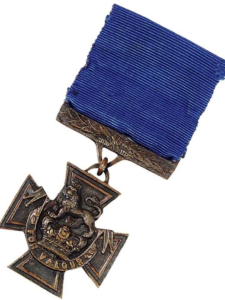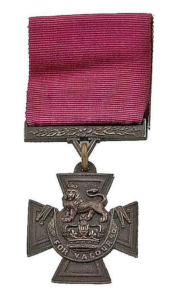The Warrant Instituting the Victoria Cross in 1856
Public Record Office WO 98 / 1
Firstly: It is ordained that the distinction shall be styled and designated ‘THE VICTORIA CROSS' and shall consist of a Maltese Cross of bronze with Our Royal Crest in the centre and underneath which, an inscroll bearing the inscription, ‘For Valour'.
Secondly: It is ordained that the Cross shall be suspended from the left breast by a blue riband for the navy, and by a red riband for the army.
Thirdly: It is ordained that the names of those upon whom We may be pleased to confer the decoration shall be published in The London Gazette, and a registry thereof kept in the office of Our Secretary of State for War.
Fourthly: It is ordained that anyone who, after having received the Cross, shall again perform an act of bravery, which, if he had not received such Cross, would have entitled him to it, such further act shall be recorded by a Bar attached to the riband by which the Cross is suspended, and for every additional act of bravery an additional Bar may be added.
Fifthly: It is ordained that the Cross shall only be awarded to those officers or men that have served Us in the presence of the enemy, and shall have performed some signal act of valour or devotion to their country.
Sixthly: It is ordained, with a view to place all persons on a perfectly equal footing in relation to eligibility for the decoration, that neither rank, nor long service, nor wounds, nor any other circumstance or condition whatsoever, save the merit of conspicuous bravery, shall be held to establish a sufficient claim to the honour.
There were other conditions but the six above capture the main elements of The Royal Warrant of 29 January 1856. The Award of the Victoria Cross could be made to all Ranks and Services for ‘extreme bravery in the face of the enemy’.
Since the inception of the VC, there have been 14 further Royal Warrants that have changed the original terms and conditions set out for awards. Recognising the bravery of civilian volunteers during the Indian Mutiny (1857-59), an 1858 warrant extended the eligibility of the VC to ‘non-military persons’ serving with the forces.
The George Cross (GC) is the highest award bestowed by the British government for non-operational gallantry or gallantry not in the presence of an enemy. It was only established on 24 September 1940.
A specimen design for the Victoria Cross was approved on 3 March 1856 – it was to be made from metal with no intrinsic value. There has been much debate about the source of the metal used. The most accepted source of metal is that of cascabels from 2 cannons captured from the Russians at Sebastopol during the Crimean War.
The medal has always been made by Hancocks of London since 1856 and more information about its manufacture etc can be found on their site at: https://www.hancocks-london.com/about-us/victoria-cross/.
Sources suggest that there is only sufficient metal now held to make between 80 and 85 medals. This may not be as critical as first seems. As the nature of warfare has changed over the decades there are much less hand to hand, face to face operations. The situations that may typically have created the circumstances for extreme bravery in presence of the enemy are very much reduced. There have only been 18 Awards since the end of World War 2.
All announcements, like that of Robert Anderson Dunsire VC, are made in The London Gazette. The first 85 servicemen to receive the award and medal were announced on 24 February 1857 and the first Investiture by Queen Victoria was held in Hyde Park, London on 26 June 1857.
The dark blue ribbon was withdrawn after the formation of the RAF on 1 April 1918. King George V signed a Warrant on 22 May 1920 stating all ribbons would be the original Army Ribbon colour of Red.
Originally, all NCOs and Private soldiers or seamen were entitled to a £10 Annuity. There is no record that I can find that proves that Robert Anderson Dunsire VC ever received such a payment.
a). The latest annuity of £2129 was paid with effect from 7 April 2014 and increases each year in line with other pension increases (currently increased by CPI). It is exempt from Tax.
b. The annuity is paid annually in arrears on the anniversary of the act of bravery for which the recipient is honoured.
c. The annuity is paid for life, however, if an individual who is in receipt of the VC dies before the annuity is payable for that year, nothing is payable for that year.
The most recent Victoria Cross award in the UK was to Lance Corporal Joshua Leakey of 1st Battalion, the Parachute Regiment, whose VC was gazetted in February 2015, following an action in Afghanistan on 22 August 2013.
There have only been 18 Awards since World War 2, There were 633 Awards in World War 1, of which 188 were posthumous. There were 182 Awards in World War 2, of which 87 were posthumous.
Beginning with the Centennial of Confederation in 1967, Canada, followed in 1975 by Australia and New Zealand, developed their own national honours systems, separate from and independent of the British or Imperial honours system. As each country's system evolved, operational gallantry awards were developed with the premier award of each system—the Victoria Cross for Australia in 1991, the Canadian Victoria Cross in 1993 and the Victoria Cross for New Zealand in 1999 —being created and named in honour of the Victoria Cross. These are unique awards of each honours system, recommended, assessed, gazetted, and presented by each country.
Robert Anderson Dunsire is a member of an elite group of 1355 men awarded the Victoria Cross over the past 150+ years, having served their country with distinction and with extreme bravery in the presence of the enemy.
Though eligible, no woman has ever been awarded the Victoria Cross.
Robert was the second born Fifer to be awarded the Victoria Cross during World War 1. Lance Corporal David Finlay, who was born in Guardbridge on 29 January 18993, was a full-time soldier serving with the 2nd Battalion of The Black Watch (The Royal Highlanders). His Act of Valour took place on 9 May 1915 during action at Rue du Bois and Aubers Ridge in Pas de Calais. David’s Victoria Cross award was announced in The London Gazette on 29 June 1915. Over the rest of the period of World War 1, three more Fife born soldiers were to be awarded the Victoria Cross.

